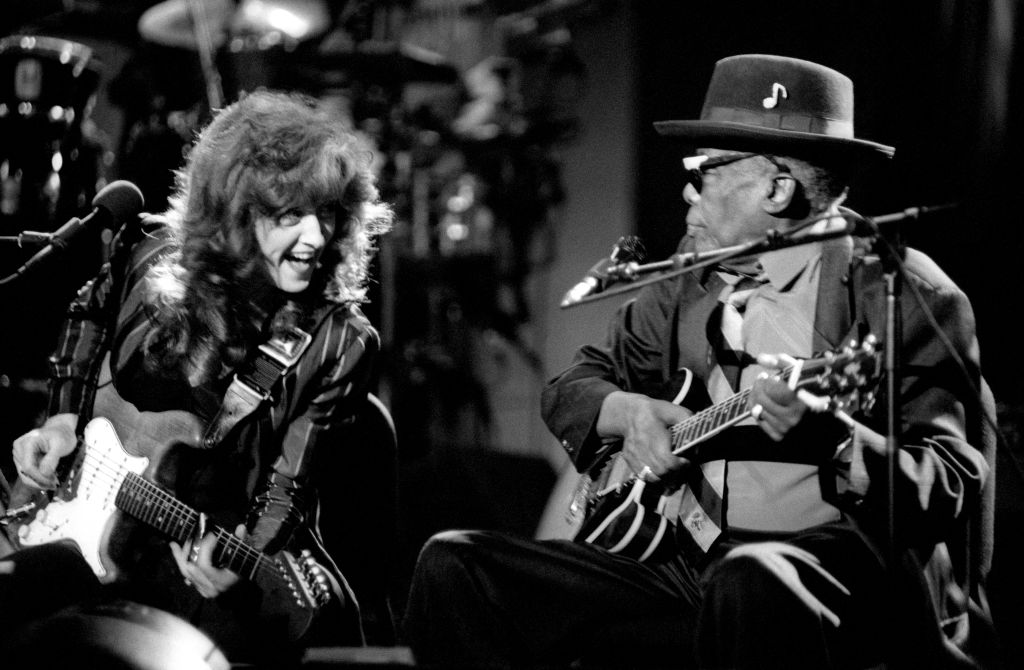Learn to Play Slide Like Bonnie Raitt
An in-depth look at the subtle artistic and technical elements behind her celebrated and highly emotive slide playing.

Looking back on the years I spent developing as a guitarist, I often kick myself for having taken certain musicians for granted – guitarists who always sounded so good but whose style I dismissed as “easy” to play.
While I was focused on learning solos crowded with notes, another musical world was passing me by. This is not to say that playing a lot of notes isn’t musical; it all depends on when and how you do it.
But that’s a lesson for another day.
I save one of my hardest kicks for when I think of Bonnie Raitt.
From listening to Raitt and players like her, I learned that being a good guitarist requires playing with an emphasis on musicality and tasteful note choices, along with a dedication to making a solo serve the song.
This requires a different kind of technique, one that is more subtle and surely not easy.
I’m going to try to make up for all that lost time by exploring Raitt’s unique approach to music, and more specifically, the guitar.

It’s almost as if Raitt has two voices. When listening to her songs, her smooth and soulful vocal style is immediately apparent. But when she lays down some of her signature open-tuned slide guitar licks, it becomes clear that she is a musician of great depth.
Before we dive into her guitar work, let’s talk about Raitt’s tone.
She doesn’t require anything elaborate or wildly expensive to achieve her warm, sustaining sound. Her main electric guitar, Brownie, is a Fender Strat that pairs an unpainted 1965 body with a neck from an unknown year.
It has long been her faithful onstage companion, and she hasn’t played a show without it since the late night in 1969 when she bought it for a whopping $120. The price was right, and she loved how it sounded.
Raitt strings the guitar with a custom set of GHS Boomers, in gauges .013, .017, .020w, .032, .042 and .052.

For amplification, Bonnie plugs her Strat into a Bad Cat Black Cat 30R 1x12 combo, while ultimately achieving her warm, overdriven tone with the simple addition of a ProCo Rat distortion pedal. She recently replaced her Boss CS-2 compressor with yet another classic, the MXR Dyna Comp, which provides all the sustain she needs to conjure the long-lasting notes that are a hallmark of her style.
Add in her Dunlop bottleneck slide and custom Dunlop molded-plastic fingerpicks, and that’s it!
So let’s turn our focus to how she plays, as this is what contributes most to her unique blend of rock, R&B, blues, and soul.
Chicago blues giant Muddy Waters was a major influence on Raitt, with his electrifying guitar style and ability to sustain a long career, something she was determined to achieve for herself. Other influences include a host of blues artists such as Howlin’ Wolf, Mississippi Fred McDowell and Furry Lewis, all of whom, like Waters, played fingerstyle blues guitar and incorporated slide work.
But Raitt was also drawn to the early rock and roll of Elvis Presley and Fats Domino, as well as the 1960s folk movement led by the likes of Pete Seeger and Peter, Paul & Mary. Their emphasis on activism resonated with Bonnie, and she would soon begin an earnest dedication to environmental and human rights causes that she continues today.

An important element of Raitt’s playing is her use of open tunings and capos.
She most often plays in open A tuning (low to high: E, A, E, A, C#, E), but she also uses open G, which is the same tuning scheme transposed down one whole step (low to high: D, G, D, G, B, D). (All slide guitar examples in this lesson are presented in open G.)
Raitt often employs open strings in her rhythm and slide playing, and will often use a capo based on a song’s key, most often at the 3rd or 5th frets. For example, if her guitar is tuned to open A and the song is in the key of C major, she will often place her capo at the 3rd fret.
This will cause the open strings to produce a C chord – the tonic or “home” chord – giving her the opportunity to incorporate any “open” string she likes.
When it comes to playing slide guitar, Raitt isn’t in a hurry.
For example, when playing a melodic theme or guitar solo, she’ll often include a long, slow slide to create a mix of anticipation and plaintive longing.

Ex. 1 illustrates this approach with a phrase in the style of “Unintended Consequence of Love,” from 2012’s Dig in Deep. (For ease of reading, all music examples that require a capo are written in the key of G major, instead of the actual sounding key. The capo-ed fret is “0” in the tab.)
Another signature slide move of Bonnie’s is to slowly slide a note down the neck.

Ex. 2 is reminiscent of a phrase she plays in “Thing Called Love,” from her breakthrough 1989 album, Nick of Time.
Notice how the first note is left to simply hang in the air.
Like other great guitarists, she has a sublime vibrato, but she knows when not to use it.
Raitt also employs another subtle approach when sliding into a note from above, as she sometimes uses a quick slide starting from a whole step, or two frets, higher.

Inspired by “Love Letter,” also from Nick of Time, Ex. 3 demonstrates how this snarky little slide move can inject some attitude into your playing.
While playing a song in a major key, Raitt will frequently (and slyly) borrow notes from its parallel minor pentatonic scale, which is built from the same root.
For example, if a song is in the key of G major, she’ll often be inclined to use notes from G minor pentatonic, which is spelled G (the root), Bb (the minor, or “flatted,” 3rd), C (the perfect 4th), D (the perfect 5th) and F (the minor, or “flatted,” 7th).
The “blue” notes here – the b3 and b7 – are her targets, as the three remaining notes are duplicated in the G major scale (G, A, B, C, D, E, F#).

Ex. 4 is reminiscent of Raitt’s playing in “Something to Talk About,” from her 1991 Grammy-winning album, Luck of the Draw.
We’re again in the key of G major here, and, if you look at the music notation, you’ll see how Bb (the b3) and F (the b7) are borrowed from the G minor pentatonic scale. But notice how they’re prevented from coming across too harshly by quickly moving on to diatonic notes from the G major scale right next door (A and E, respectively).
This creates a sound that is as soulful as it is bluesy.
Raitt will take advantage of this approach often, and in such a way as to make it always sound fresh.

Let’s take a quick detour to discuss Raitt’s rhythm guitar style, when she’ll often give her slide a rest. If you’re unfamiliar with her earlier albums, you might be surprised to hear her playing in a more traditional blues style.
Ex. 5 brings to mind “Love Me Like a Man” from her 1972 album, Give It Up.
Played without a slide, and in standard tuning, it offers up a classic fingerstyle blues, played with a triplet, or “shuffle,” feel. Be sure to use your pick-hand thumb on the third beat of bar 3, as indicated.

Raitt is especially masterful when interpreting ballads.
A great example is her cover of John Prine’s “Angel from Montgomery” from 1974’s Streetlights. In it, she uses both strumming and fingerpicking in the vein of Ex. 6.
The guitarist strums with the tips of her plastic fingerpicks, but if you don’t own a set, you can use the tips of your fingers in much the same way.
Note the use of drop-D tuning here, where the low E string is tuned down one whole step, to D, and a capo at the 2nd fret. Raitt will often alternate between overtly stating a song’s groove and sneakily playing her rhythm parts tucked into the band.

Ex. 7 is reminiscent of “Ain’t Gonna Let You Go” from her 2012 Grammy-winning album, Slipstream, where she lays down a funky blues groove, without using her slide.
In these situations, Raitt will often wear it – on her middle finger, as always – to give her the option to use it if she wants to.
Bonnie most often chooses to perform music by other songwriters and will commonly invest three to four years into sorting through songs in order to find an album’s worth of material to record.
However, she does perform her own songs as well. “Give It Up or Let Me Go,” a song she wrote for her album Give It Up, features her plucking fretted notes, then switching to slide partway through, making its entrance a welcome surprise.


Ex. 8 is inspired by her unaccompanied intro on this track. Raitt loves to let notes ring a tad longer than you think she might.
To accomplish this, she gently coaxes them along with a wide vibrato.

To give this a try, see Ex. 9, which is based on “Love Sneakin’ Up On You” from 1994’s Longing in Their Hearts.
Summon a wide vibrato by quickly wiggling, or “wagging,” your slide back and forth, covering the area between the adjacent frets on either side.
This technique, combined with the use of a compressor pedal, gives the guitarist the sustain she needs to wring everything out of each note, a hallmark of her style.
Bonnie Raitt’s phrasing and touch are what place her among a select group of soulful and expressive guitarists who make you sit up and listen even though it can be confounding to figure out just what makes them sound so good.
There’s a lot going on “behind the scenes” of Raitt’s seemingly effortless approach to music that has enabled her to achieve the Muddy Waters-like longevity she envisioned for herself over 50 years ago.
To her credit, she has consistently done it in her own self-effacing, understated way – all the while making it look “easy.”
Get The Pick Newsletter
All the latest guitar news, interviews, lessons, reviews, deals and more, direct to your inbox!
Jeff Jacobson is a guitarist, songwriter and veteran music transcriber, with hundreds of published credits. For information on virtual guitar and songwriting lessons or custom transcriptions, reach out to Jeff on Twitter @jeffjacobsonmusic or visit jeffjacobson.net.
“Write for five minutes a day. I mean, who can’t manage that?” Mike Stern's top five guitar tips include one simple fix to help you develop your personal guitar style
"It’s like you’re making a statement. And you never know where it’ll lead." Pete Thorn shares the tip that convinced Joe Satriani he was the right guitarist for the SatchVai Band











